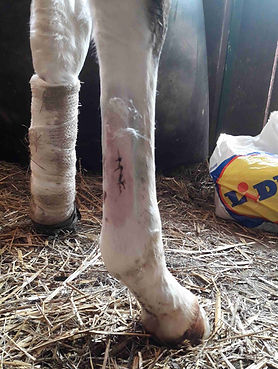
Title (Diagnosis): 4.2.2. Flexural deformity in the foal
1. Author: Miloslav Kreps, CE-F
Place of work: Popelka
2. Literary overview: Podkovářství, ISBN: 978-80-7490-052-5, Tisk Pálka 2015
3. Data of the patient No. 4.2.2.
Breed: Paint horse
Sex: Stallion
Age: 9. weeks old
Color: Skewbald
Type of work: Rearing
Reason, why the owner complains: The foal has problems with movement.
Duration of the problems: approx. 3 weeks
Stabling conditions: 24/7 outside
Surface on which the moves most often: Grassy field
Frequency of the hoof care: firts trim in fourth week of age
Type of shoeing: None
Lameness, diagnosis: Significant flexity of forelimbs, caused by rapid growth of the foal
4. Anamnesis:
5. Case description:
Charakteristics of the changes: Excessive and rapid growth of the foal caused flexity of the forelimbs.
Shape of the hooves and pathological changes: Club feet, bent dorsal hoof walls, heels not in contact with the ground.
Limbs conformation: Due to the pull of the shortened DDFT the foal stands on the toes of his hooves.



Fig. 1. and 2.: Stance before trim - 19.8.2018
Video 1.: Movement of the foal before trim - 19.8.2018
6. Chosen measures:
Trimming: We performed a basic trim of the hooves and glued a Dallmer shoe with heel support to decrease the pull of DDFT and its relaxation on both forelimbs.
Prepapartion of shoes: After trim we prepared the Dallmer shoes with wedge.
Shoeing: To protect the coronary band, we applied adhesive tape around the whole perimeter, than we glued the Dallmer shoes on and lastly, the wedges (heel support) were screwed on the shoes. Left front hoof was treated first, beacause it seemed to be more affected, after that we applied the right shoe.
Veterinary measures: Adjustment of mother’s feed ration.


Fig. 3 and 4.: Stance after trim and shoes application - 19.8.2018
7. Development of changes
Efect of the first trim
Immediatelly after application was visible improved function of the DDFT.
Changes in shoe choice and shoeing:
At follow-up after 5 days was found out that taken measures were not sufficient for right front limb.
Effect of the first treatment:
Despite all the regular adjustments and use of Dallmer's shoes, the development has not improved for the better.
Result of the care:
At 18.10. 2018 attending vet decided for desmotomy of the deep digital flexor tendon. In this case, desmotomy of the accessory ligament of DDFT was assessed as insufficient.



Fig. 5. - 7.: We have used aluminium sheet metal as support. We have created a wedge in the heel area by appliing Superfast between the metal sheet and Dallmer shoe wedge. Dorsal part of the shoe was created longer, to prevent bending over in the coffin joint.


Effect of the second treatment:
Before the desmotomy, we have created a support to dorsal part of the hoof using the Superfast.
Fig. 8. - 9.:
Left front limb at first change of dressing.
Following treatment:
Until April 2019 hooves were trimmed regularly every 10-14 days. Since April 2019 the period was prolonged to 5-7 weeks.

Vid. 2.:
Movement of the foal at 8.12.2019




Fig. 10. - 13.:
Foal’s hooves in May 2019

